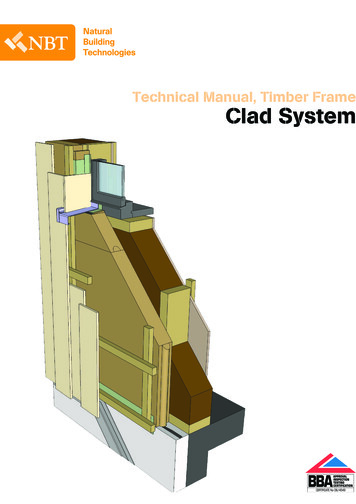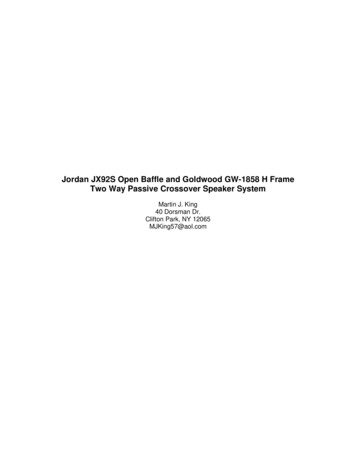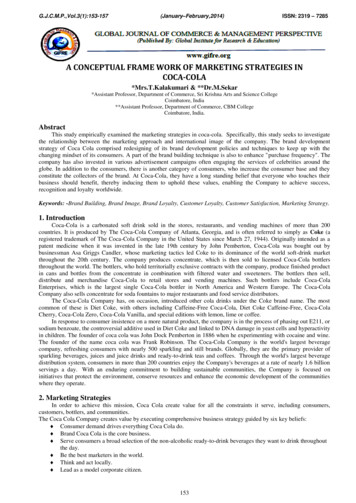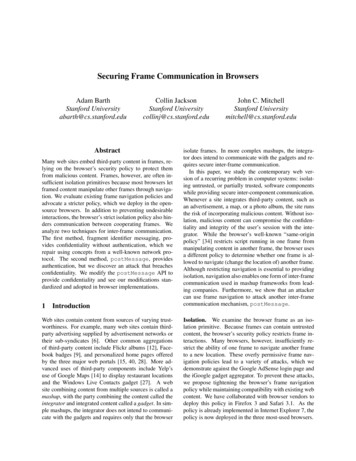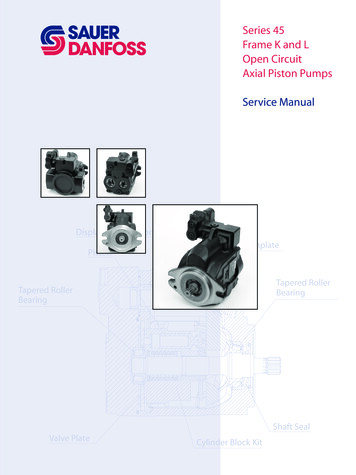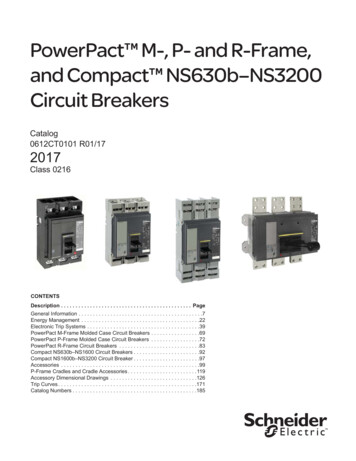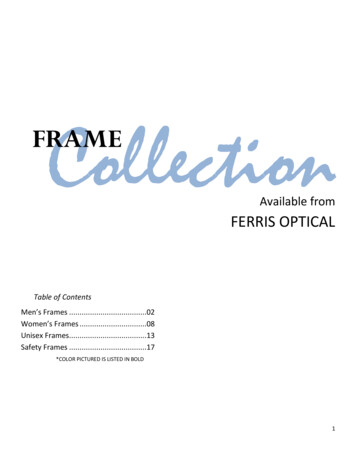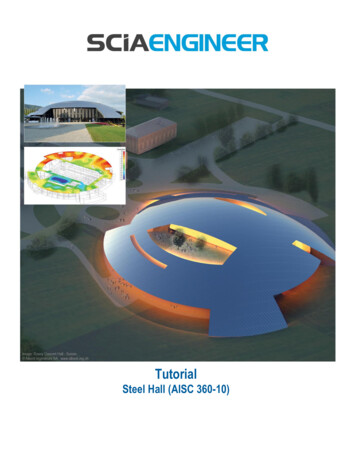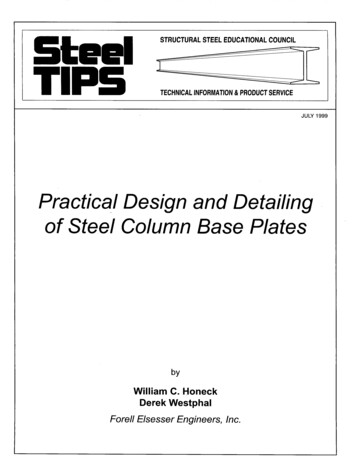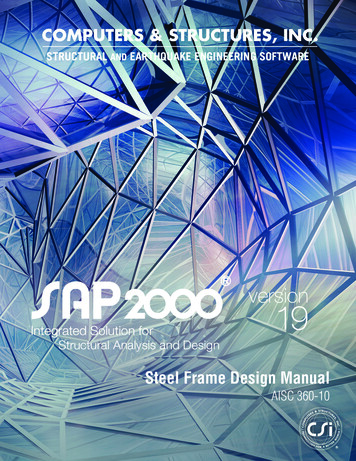
Transcription
Steel Frame Design ManualAISC 360-10
Steel FrameDesign ManualAISC 360-10For SAP2000 ISO SAP102816M9 Rev. 0Proudly developed in the United States of AmericaOctober 2016
CopyrightCopyright Computers and Structures, Inc., 1978-2016All rights reserved.The CSI Logo and SAP2000 are registered trademarks of Computers and Structures,Inc. Watch & LearnTM is a trademark of Computers and Structures, Inc.The computer program SAP2000 and all associated documentation are proprietary andcopyrighted products. Worldwide rights of ownership rest with Computers andStructures, Inc. Unlicensed use of these programs or reproduction of documentation inany form, without prior written authorization from Computers and Structures, Inc., isexplicitly prohibited.No part of this publication may be reproduced or distributed in any form or by anymeans, or stored in a database or retrieval system, without the prior explicit writtenpermission of the publisher.Further information and copies of this documentation may be obtained from:Computers and Structures, Inc.www.csiamerica.cominfo@csiamerica.com (for general information)support@csiamerica.com (for technical support questions)
DISCLAIMERCONSIDERABLE TIME, EFFORT AND EXPENSE HAVE GONE INTO THEDEVELOPMENT AND DOCUMENTATION OF THIS SOFTWARE. HOWEVER,THE USER ACCEPTS AND UNDERSTANDS THAT NO WARRANTY ISEXPRESSED OR IMPLIED BY THE DEVELOPERS OR THE DISTRIBUTORS ONTHE ACCURACY OR THE RELIABILITY OF THIS PRODUCT.THIS PRODUCT IS A PRACTICAL AND POWERFUL TOOL FOR STRUCTURALDESIGN. HOWEVER, THE USER MUST EXPLICITLY UNDERSTAND THE BASICASSUMPTIONS OF THE SOFTWARE MODELING, ANALYSIS, AND DESIGNALGORITHMS AND COMPENSATE FOR THE ASPECTS THAT ARE NOTADDRESSED.THE INFORMATION PRODUCED BY THE SOFTWARE MUST BE CHECKED BYA QUALIFIED AND EXPERIENCED ENGINEER. THE ENGINEER MUSTINDEPENDENTLY VERIFY THE RESULTS AND TAKE PROFESSIONALRESPONSIBILITY FOR THE INFORMATION THAT IS USED.
Contents12Introduction1.1Load Combinations and Notional Loads1-21.2Stress Check1-21.3Direct Analysis Method vs. Effective Length Method1-31.3.11.3.21-41-4Effective Length MethodDirect Analysis Method1.4User Options1-51.5Non-Automated Items in Steel Frame Design1-5Design Algorithms2.1Check and Design Capability2-12.2Design and Check Stations2-22.3Demand/Capacity Ratios2-3i
Steel Frame Design AISC 360-103ii2.4Design Load Combinations2-42.5Second Order P-Delta Effects2-52.6Analysis Methods2-62.7Notional Load Patterns2-102.8Member Unsupported Lengths2-112.9Effects of Breaking a Member into Multiple Elements2-122.10 Effective Length Factor (K)2-142.11 Supported Framing Types2-172.12 Continuity Plates2-182.13 Doubler Plates2-202.14 Choice of Units2-21Steel Frame Design Using ANSI/AISC 360-103.1Notations3-23.2Design Loading Combinations3-63.3Classification of Sections for Local Buckling3-93.4Calculation of Factored Forces and Moments3-183.5Calculation of Nominal Strengths3-223.5.13-23Nominal Tensile Strength
Contents3.5.23.5.33.5.43.5.53.6Design of Members for Combined Forces3.6.13.6.23.6.33.6.44Nominal Compressive StrengthNominal Flexure StrengthNominal Shear StrengthNominal Torsional StrengthDoubly and Singly Symmetric MembersSubjected to Flexure and Axial CompressionDoubly and Singly Symmetric MembersSubjected to Flexure and Axial TensionUnsymmetric Members Subjected to Flexureand Axial ForceMembers Subject to Torsion, Flexure, Shearand Axial Force3-233-343-653-713-733-743-773-793-81Special Seismic Provisions (ANSI/AISC 341-10)4.1Notations4-24.2Design Preferences4-24.3Overwrites4-34.4Supported Framing Types4-34.5Applicability of the Seismic Requirements4-44.6Design Load Combinations4-44.7Classification of Sections for Local Buckling4-74.8Special Check for Column Strength4-114.9Member Design4-124.9.14.9.24.9.34-124-134-13Ordinary Moment Frames (OMF)Intermediate Moment Frame (IMF)Special Moment Frames (SMF)iii
Steel Frame Design AISC 360-104.9.44.9.54.9.6Special Truss Moment Frames (STMF)Ordinary Concentrically Braced Frames (OCBF)Ordinary Concentrically Braced Frames fromIsolated Structures (OCBFI)4.9.7 Special Concentrically Braced Frames (SCBF)4.9.8 Eccentrically Braced Frames (EBF)4.9.9 Buckling Restrained Braced Frames (BRBF)4.9.10 Special Plate Shear Walls4-154-164-174-214-234.10 Joint 344-374-40Design of Continuity PlatesDesign of Doubler PlatesWeak Beam Strong Column MeasureEvaluation of Beam Connection ShearsEvaluation of Brace Connection ForcesAppendix A P-Delta EffectsAppendix B Steel Frame Design PreferencesAppendix C Steel Frame Design Procedure OverwritesAppendix D Interactive Steel Frame DesignAppendix E Analysis Sections vs. Design SectionsAppendix F Error and Warning MessagesBibliographyiv4-144-14
Chapter 1IntroductionThe design/check of steel frames is seamlessly integrated within the program.Initiation of the design process, along with control of various design parameters, is accomplished using the Design menu. Automated design at the objectlevel is available for any one of a number of user-selected design codes, aslong as the structures have first been modeled and analyzed by the program.Model and analysis data, such as material properties and member forces, arerecovered directly from the model database, and are used in the design processin accordance with the user defined or default design settings. As with all design applications, the user should carefully review all of the user options anddefault settings to ensure that the design process is consistent with the user’sexpectations. The AISC 360-10 steel frame design options include the use ofthe Direct Analysis Method. The software is well suited to make use of the Direct Analysis Method because it can capture the second-order P-Delta and P-δeffects, provided the user specifies that a nonlinear P-Delta analysis be performed.Chapter 2 addresses prerequisites related to modeling and analysis for a successful design in accordance with “AISC 360-10.” Chapter 3 provides detaileddescriptions of the specific requirements as implemented in “AISC 360-10.”Chapter 4 provides detailed descriptions of the specific requirements for seismic loading as required by the specification in ANSI/AISC 341-10 code. Theappendices provide details on various topics referenced in this manual. The user also should review the AISC Direct Analysis Method Practical Guide.1-1
Steel Frame Design AISC 360-101.1Load Combinations and Notional LoadsThe design is based on a set of user-specified loading combinations. However,the program provides default load combinations for each supported designcode. If the default load combinations are acceptable, no definition of additional load combinations is required. The Direct Analysis Method requires that anotional load, N 0.002Yi , where Yi is the gravity load acting at level i, beapplied to account for the destabilizing effects associated with the initial imperfections and other conditions that may induce sway not explicitly modeled inthe structure. The user must be aware that notional loads must be defined andassigned by the user. Currently, the software creates design combinations thatinclude notional loads and gravity loads only. If the user needs notional loadsthat include combinations containing lateral loads, the user must define suchcombinations manually. The automation of combinations, including notionalloads, is currently limited to gravity loads only. Design load combinations ofnotional loads acting together with lateral loads currently are NOT automatedby the software.1.2Stress CheckSteel frame design/check consists of calculating the flexural, axial, and shearforces or stresses at several locations along the length of a member, and thencomparing those calculated values with acceptable limits. That comparisonproduces a demand/capacity ratio, which typically should not exceed a value ofone if code requirements are to be satisfied. The program follows the samereview procedures whether it is checking a user-specified shape or a shapeselected by the program from a predefined list. The program also checks therequirements for the beam-column capacity ratio, checks the capacity of thepanel zone, and calculates the doubler plate and continuity plate thickness, ifneeded. The program does not do the connection design. However, it calculatesthe design basis forces for connection design.Program output can be presented graphically on the model, in tables for bothinput and output data, or in calculation sheets prepared for each member. Foreach presentation method, the output is in a format that allows the engineer toquickly study the stress conditions that exist in the structure, and in the eventthe member is not adequate, aid the engineer in taking appropriate remedial1-2Load Combinations and Notional Loads
Chapter 1 Introductionmeasures, including altering the design member without re-running the entireanalysis.The program supports a wide range of steel frame design codes, includingmany national building codes. This manual is dedicated to the use of the menuoption “AISC 360-10.” This option covers the “ANSI/AISC 360-10 Specification for Structural Steel Buildings” (AISC 2010a, b), and the “ANSI/ AISC341-10 Seismic Provisions for Structural Steel Buildings” (AISC 2010c) codes.The implementation covers loading and load combinations from “ASCE/SEI7-10 Minimum Design Loads for Buildings and Other Structures” (ASCE2010), and also special requirements from “IBC 2012 International BuildingCode” (IBC 2012). Both LRFD (Load and Resistance Factor Design) and ASD(Allowable Strength Design) codes are included in this implementation underthe same AISC 360-10 code name. The LRFD and ASD are available as twooptions in the program’s preferences feature. In both cases, the strengths arecalculated in the nominal levels. The phi (LRFD) and Omega (ADS) factorsare applied during calculation of demand/capacity ratios only. The designcodes supported under “AISC 360-10” are written in kip-inch units. All the associated equations and requirements have been implemented in the program inkip-in units. The program has been enabled with unit conversion capability.This allows the users to enjoy the flexibility of choosing any set of consistentunits during creating and editing models, exporting and importing the modelcomponents, and reviewing the design results.1.3Direct Analysis Method vs. Effective LengthMethodThe Direct Analysis Method described in AISC 360-10, Chapter C, issubstantially different from previous design methods supported by AISC. Theuser should be knowledgeable about the Design for Stability (Chapter C)requirements and the requirements pertaining to consideration of the geometricimperfections, stiffness reductions, and the P-Δ and P-δ effects. Severalmethods for consideration of the second-order effects are available to the users.Each of these are described in detail in a subsequent section (see User Optionsin this chapter) and in the Steel Frame Design Preferences, Appendix B of thismanual. Alternatively, if the user desires to use a more traditional designDirect Analysis Method vs. Effective Length Method1-3
Steel Frame Design AISC 360-10method, the Effective Length method can be specified using the DesignPreferences.1.3.1 Effective Length MethodFor structures exhibiting small second-order effects, the effective lengthmethod may be suitable. The effective length approach relies on two mainassumptions, namely, that the structural response is elastic and that all columnsbuckle simultaneously. The effective length method also relies on a calibratedapproach to account for the differences between the actual member responseand the 2nd-order elastic analysis results. The calibration is necessary becausethe 2nd-order elastic analysis does not account for the effects of distributedyielding and geometric imperfections. Since the interaction equations used inthe effective length approach rely on the calibration corresponding to a 2ndorder elastic analysis of an idealized structure, the results are not likelyrepresentative of the actual behavior of the structure. However, the results aregenerally conservative. In the AISC 360-10 code, the effective length methodis allowed provided the member demands are determined using a second-orderanalysis (either explicit or by amplified first-order analysis) and notional loadsare included in all gravity load combinations (AISC Appendix 7). K-factorsmust be calculated to account for buckling (except for braced frames, or whereΔ2 /Δ1 1.5, K 1.0) (AISC App. 7.2).1.3.2 Direct Analysis MethodThe Direct Analysis Method is expected to more accurately determine theinternal forces of the structure, provided care is used in the selection of theappropriate methods used to determine the second-order effects, notional loadeffects and appropriate stiffness reduction factors as defined in AISC C2.Additionally, the Direct Analysis Method does not use an effective lengthfactor other than K 1.0. The rational behind the use of K 1.0 is that properconsideration of the second-order effects (P- and P-δ), geometricimperfections (using notional loads) and inelastic effects (applying stiffnessreductions) better accounts for the stability effects of a structure than the earlierEffective Length methods.1-4Direct Analysis Method vs. Effective Length Method
Chapter 1 Introduction1.4User OptionsIn addition to offering ASD and LRFD design, the Design Options menu provides seven analysis methods for design, as follows: General Second Order Elastic Analysis (AISC C1.2) Second Order Analysis by Amplified First Order Analysis (AISC C1.2,App. 7.2, App. 8.2) Limited First Order Elastic Analysis (AISC C1.2, App. 7.3) Direct Analysis Method with General Second Order Analysis and VariableFactor Stiffness Reduction (AISC C1, C2) Direct Analysis Method with General Second Order Analysis and FixedFactor Stiffness Reduction (AISC C1, C2) Direct Analysis Method with Amplified First Order Analysis
The AISC 360-10 steel frame design options include the use of the Direct Analysis Method. The software is well suited to make use of the Di-rect Analysis Method because can capture the seit ondc -order P-Delta and P-δ effects, provided the user specifies that a nonlinear P-Delta analysis be per-formed. Chapter 2 addresses prerequisites related to modeling and analysis for a suc-cessful design .
